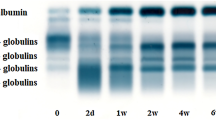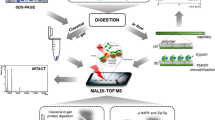Abstract
IT is now known that α-casein from cow milk, which appears electrophoretically homogeneous under many different conditions, consists of at least two compounds which have been designated α- and k-casein1. α-Casein from goat milk, which has similar properties to that from cow milk2 and the same phosphorus content3, showed signs of inhomogeneity during electrophoresis by the moving-boundary method2. Using zone electrophoresis on filter paper it has now been found that the α-component of freshly prepared goat casein does consist of at least two electrophoretically distinct fractions which, until further characterization, will be called α1- and α2-casein in order of decreasing electrophoretic mobility.
This is a preview of subscription content, access via your institution
Access options
Subscribe to this journal
Receive 51 print issues and online access
$199.00 per year
only $3.90 per issue
Buy this article
- Purchase on Springer Link
- Instant access to full article PDF
Prices may be subject to local taxes which are calculated during checkout
Similar content being viewed by others
References
Waugh, D., and von Hippel, P. H., J. Amer. Chem. Soc., 78, 4576 (1956).
Dovey, A., and Campbell, P. N., Nature, 169, 1014 (1952).
Hofman, T., Biochem. J. (in the press).
Warner, R. C., J. Amer. Chem. Soc., 66, 1725 (1944).
Author information
Authors and Affiliations
Rights and permissions
About this article
Cite this article
HOFMAN, T. Inhomogeneity of α-Casein from Goat Milk. Nature 181, 633–634 (1958). https://doi.org/10.1038/181633b0
Issue Date:
DOI: https://doi.org/10.1038/181633b0
Comments
By submitting a comment you agree to abide by our Terms and Community Guidelines. If you find something abusive or that does not comply with our terms or guidelines please flag it as inappropriate.



